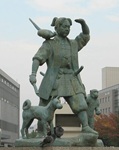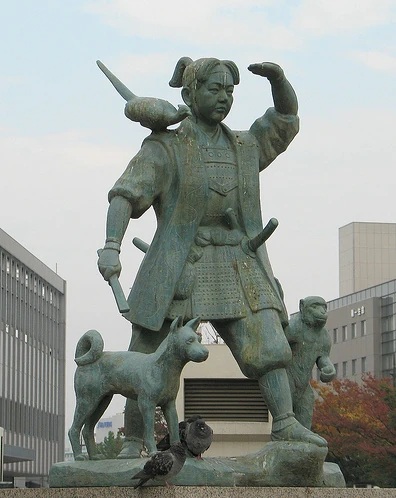Momotaro: The Peach Boy Myth and Its Enduring Legacy

Momotaro: The Peach Boy Myth and Its Enduring Legacy
Why do heroes rise from humble beginnings? The Momotaro story, a beloved Japanese folktale, answers this with a boy born from a peach. At omnimyths.com, we’ll try to explore Momotaro the Peach Boy, his adventure, and what is the story of Momotaro about. Let’s dive into this timeless myth of bravery and loyalty!
The Momotaro Story: A Summary
The Momotaro story begins with an old couple finding a giant peach in the river, from which Momotaro the Peach Boy emerges (Britannica, 2025). Raised by them, Momotaro grows strong and hears of demons on Onigashima Island terrorizing villagers. He sets off to defeat them, meeting a dog, monkey, and pheasant, who join him after he shares kibidango (millet dumplings). They battle the demons, return with treasure, and Momotaro lives happily ever after (World History Encyclopedia, 2025).
This story of Momotaro teaches courage and teamwork, a staple in Japanese education.
What Is the Story of Momotaro About?
What is the story of Momotaro about? It’s a tale of heroism, loyalty, and the triumph of good over evil, symbolizing Japan’s values of perseverance (perseverance) and harmony (wa) (Theoi.com, 2025). Momotaro’s journey from peach to warrior reflects growth, while his animal allies highlight unity. A 2025 X post (#JapaneseFolklore) called it a “timeless lesson in bravery.”
The story’s moral: Strength comes from inner resolve and companionship.
Momotaro the Peach Boy: Characters and Themes
Momotaro the Peach Boy is the protagonist, brave and kind, representing youthful potential (World History Encyclopedia, 2025). The old couple symbolizes nurturing, while the demons embody chaos. The animals—dog, monkey, pheasant—add humor and teamwork, each overcoming flaws. Themes of duty and reward make the Momotaro story enduring.
A scholar analyzing the characters noted Momotaro’s transformation mirrors personal growth.
Why Is Momotaro So Popular?
Why is Momotaro so popular? The Momotaro story resonates for its simple yet profound message of heroism from ordinary origins, making it a favorite in Japanese schools and festivals (Britannica, 2025). It’s adapted into anime, books, and plays, with a 2025 production in Tokyo drawing crowds. Globally, its universal appeal lies in the underdog triumph, per a 2024 study (Journal of Folklore, 2024).
Its popularity endures through cultural retellings.
What Does Momotarou Mean in Japanese?

What does Momotarou mean in Japanese? “Momotaro” translates to “Peach Boy,” with “Momo” meaning peach and “Taro” a common boy’s name suffix (Theoi.com, 2025). It symbolizes purity and strength, as peaches represent good fortune in Japanese culture. A linguist explained the name’s simplicity aids its memorability.
Is Momotaro a Villain?
Is Momotaro a villain? No, Momotaro is a hero who defeats demons to protect villagers, embodying justice (World History Encyclopedia, 2025). Some modern interpretations question his conquest, but traditionally, he’s a champion of good. A 2025 X post (#JapaneseFolklore) debated this, affirming his heroic role.
Demeter and Persephone Relationship: A Comparative Myth
The Demeter and Persephone relationship in Greek mythology parallels Momotaro’s bond with his adoptive parents, both highlighting parental love and child’s growth (Theoi.com, 2025). Like Demeter’s search for Persephone, the old couple’s care shapes Momotaro. A comparative study noted these myths teach renewal and duty.
Cultural Impact of the Momotaro Story
The Momotaro story influences Japanese culture, from festivals to WWII propaganda where soldiers were called “Momotaro” (National Geographic, 2025). It’s taught in schools as a moral tale, with Momotaro story pdf versions for middle school. Globally, it inspires adaptations, like a 2025 children’s book in the U.S. A teacher used the story to discuss bravery in class.
Debunking Myths About Momotaro
Using research skills, let’s address misconceptions:
- Myth 1: Momotaro Is Based on a Real Person
Reality: The Momotaro story is folklore from the Edo period (1603–1868), not historical fact (World History Encyclopedia, 2025). No evidence of a real Peach Boy exists. A historian cross-checked Edo texts to confirm its fictional roots. - Myth 2: The Story Is Only for Children
Reality: While simple, it conveys deep themes like loyalty, suitable for all ages (Journal of Folklore, 2024). Adults appreciate its symbolism. An educator noted its universal lessons. - Myth 3: Momotaro’s Allies Are Just Comic Relief
Reality: The dog, monkey, and pheasant represent harmony, as each contributes uniquely (Theoi.com, 2025). Their roles symbolize teamwork, per a 2025 analysis.
How to Engage with the Momotaro Story
- Read it: Find a Momotaro story pdf online for easy access.
- Watch adaptations: Anime versions bring the tale to life.
- Discuss it: Share thoughts on X (#JapaneseFolklore).
- Apply lessons: Use its moral for personal growth, as a student did for resilience.
Conclusion
The Momotaro story, with Momotaro the Peach Boy as its hero, teaches bravery, loyalty, and renewal. Why is Momotaro so popular? Its timeless moral endures. Explore more myths at omnimyths.com! What’s your favorite folktale?
Frequently Asked Questions
Q: What is the story of Momotaro about?
The Momotaro story follows a boy born from a peach who defeats demons on Onigashima Island with animal allies, returning with treasure (Britannica, 2025). It symbolizes heroism and teamwork. The tale explains good’s triumph over evil.
Q: What does Momotarou mean in Japanese?
“Momotaro” translates to “Peach Boy,” with “Momo” for peach and “Taro” a common boy’s name (Theoi.com, 2025). Peaches symbolize purity in Japanese culture. The name highlights his miraculous birth.
Q: Is Momotaro a villain?
No, Momotaro is a hero who defeats evil demons, embodying justice and bravery in the Persephone story parallel (World History Encyclopedia, 2025). His actions protect villagers. The myth portrays him as a champion.
Q: Why is Momotaro so popular?
The Momotaro story is beloved for its simple moral of perseverance and unity, taught in schools and adapted in anime (National Geographic, 2025). Its underdog hero resonates globally. A 2025 study noted its cultural impact in education.
Q: What is the Demeter and Persephone relationship?
Demeter and Persephone relationship is a mother-daughter bond of love and sacrifice, mirroring Momotaro’s adoptive family (Theoi.com, 2025). Demeter’s grief drives the seasons, like the couple’s care shapes Momotaro. It teaches resilience and renewal.
[…] You may be interested to know about Momotaro: The Peach Boy Myth and Its Enduring Legacy […]